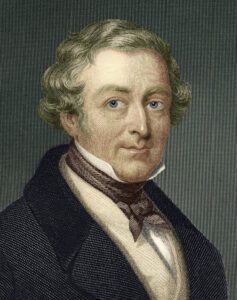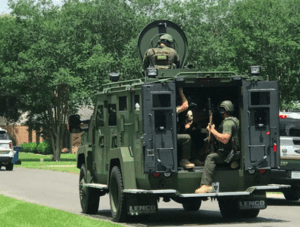In a recent piece, Violent Crime Task Force: Crime Thrives in Lack of Transparency, we highlighted a recent report of the Louisiana Violent Crime Task Force. We also offered the analogy that compared the local criminal justice system to a four-legged stool. Those legs consist of policing, corrections, prosecution, and the courts. In the next few articles on this topic, we’ll be covering the different legs. Today’s article will detail the first leg: policing.
Before the time of professional police forces, part-time citizen volunteers generally carried out these duties. This was the pervasive model in the late 1700’s and early 1800’s. Policing in colonial America took on a more hybrid approach, with a combination of elected Sheriffs, local militias, and citizen volunteers. A recent trend in revisionist history is to attach the origins of modern policing to slave patrols, which only serves to erode public trust.
Sir Robert Peel, who is often credited as being the “father of modern policing”, established three core ideas over two hundred years ago:
- The primary goal of policing is to prevent crime.
- In order to prevent crime police must earn public support.
- To earn public support police must respect community principles (in order to win public approval and assistance)
In over two centuries, there is still much relevance to the philosophy of Peel, though times have certainly changed.
Peace officer vs. Police officer
In the last few decades, there has been a major shift in policing and terminology surrounding the profession. We used to refer to a police officer as a peace officer. That was their mission – to preserve the peace, mainly through crime prevention. The role of a peace officer has shifted quickly to that of being a police or “law enforcement officer.” That’s translated to someone who is primarily concerned with the enforcement of laws, rather than the prevention of crime.
Along with this shift has been the practice of police agencies obtaining and using the most recent military surplus equipment hand-me-downs. This equipment is designed to be used against enemy combatants, not citizens. There has also been an increased reliance on surveillance equipment and technologies, which has taken officers off the street and put them behind a desk to monitor cameras. Lafayette Sheriff Garber’s Fusion Center is one such example.
Camera footage may be great at solving crimes after they have occurred, but cameras are not an effective deterrent. And spying on law abiding citizens 24/7 does not build public trust. Partnering with local surveillance profiteers has allowed police agencies to get access to over 550 license plate reader cameras and over 1,000 video cameras in southwest Louisiana alone. Has crime decreased the more we have allowed the government to spy on us? No! In fact, just about everyone is walking around with a hand-held camera in their pocket but that has not deterred crime either.
Patroling vs. specialized positions
Taking officers off the street and assigning them to “specialized positions” has also not served the core principle of crime prevention. It is hard to understand why agencies would remove a qualified police officer from police work to make them a spokesman or Public Information Officer. In times past, that role had been the responsibility of the elected Sheriff or Chief of Police. Another example involves the overuse and reliance on School Resource Officers. Schools remain one of the safest places for a child to be and it’s not because of the deployment of SROs. This condition existed well before the wide-scale police presence on our school campuses.
That’s something the Lafayette Parish School System doesn’t even want you to inquire about. Locally, we’ve had more mass shooting incidents at bars, residences, and let’s not forget the local movie theatre than we have had at schools. However, we have taken police officers away from those places to put them in school environments where crime is virtually non-existent. Here, they twiddle their thumbs with the hope that a crime will occur so they have something to do. This is not an effective crime prevention tactic. We all love and want to protect our children, but wouldn’t they be safer if we were able to curtail criminal behavior outside of the school? After all, that’s where our kids spend the majority of their time.
There will be a segment of people who say there is no price you can place on the life of a child. They are correct in the sense that life is invaluable. But if we truly believe this statement, why aren’t we building the physical school structure to a standard that provides for better child safety? Have you seen their recent designs (i.e. Southside High School)? It’s like a fish bowl surrounded by glass (and not bulletproof glass). To answer the original question – the reason we don’t build schools to a higher standard to protect our children is because up-front costs are said to be prohibitive. Policymakers in the school system don’t necessarily believe that statement either.
Police shortages
The Louisiana Violent Crime Task Force made a recommendation that the State Legislature take action to address the shortages of law enforcement officers. The thought is to provide incentives for recruitment and retention of qualified individuals. However, retention has been an issue for quite some time. Both state and federal lawmakers have attempted to address retention through legislation. However, local statistics show that we don’t have major shortages in law enforcement personnel. Many of our local municipalities are reporting they have no vacancies. Those acknowledging large numbers of vacancies, such as the Lafayette Police Department, have been riddled with a lack of stable leadership. Officers in these municipalities have also been subjected to constant attacks by their administration.
Carencro Police report having thirty-five police officers and zero vacancies. Of that number six officers are contracted out to the Lafayette Parish School System. Scott Police report having thirty police officers and zero vacancies. Five of those officers are contracted to the Lafayette Parish School System. While the Youngsville Police Department, Lafayette Police Department, and the Lafayette Parish Sheriff’s Office have not yet provided vacancy data, the Broussard Police Department has obstructed our requests.* Remember, the violent crime task force reported that there is a direct correlation between a lack of transparency and violent crime.
As it stands today in Lafayette Parish alone we have approximately 73 qualified law enforcement officers contracted out to the Lafayette Parish School System. If not for this drain on police labor would there be any vacancies in our local police market at all? The language of the contract between the school board and the participating law enforcement agency seems to exclude police staff involvement in matters unrelated to criminal activity. But we all know that is not the case. There simply is not that much criminal activity in our schools.
Instead, we have police performing the duties of education administrators and school staff. Some are even directly involved in the discipline of students and other school-related activities. When it does come to the security of our schools there is no task being carried out which could not likewise be carried out by trained private security personnel. SROs have simply become another money grab with the Lafayette Sheriff collecting a management fee of approximately $10,000 per year for every single SRO in service. That fee includes officers provided by other agencies such as the Lafayette, Broussard, Carencro, Scott, and Youngsville Police Departments.
Public support and transparency
The Peel model is based on earning the public trust. The very core of our system of government is that it is instituted to protect the rights of its citizenry, whether by military or police. Before society evolved into having professional law enforcement, citizen volunteers filled that role. Citizens remained active in the prevention of crime long after professional police forces were established. They knew and trusted their neighbors to watch after them and in turn did the same. They trusted the police enough to report suspicious activity and to assist when able or called upon.
Today, though, the police force (or at least the administrators who run them) discourages public participation. They are not forthcoming with information about the crime issues occurring in our community. Data is routinely withheld, suppressed, made difficult to obtain, or simply not maintained. How can we solve our crime problems when the public is prevented from even knowing what those problems are?
Despite all of this, our first responders remain the strongest part of our criminal justice system. They face the toughest situations head-on without the benefit of being a Monday-morning quarterback. They are in the field faced with an onslaught of aggressors forcing millisecond responses in the heat of the moment. But what can this segment of the system do, independent of the corrections system, prosecutors, or the courts, to restore peace to our community? They can have a renewed focus on crime prevention, building public support, and increased transparency.
UPDATE:
* Following the publication of the article the Broussard Police Department responded to our requests on January 12, 2024 indicating that they have thirty-nine police officers and one vacancy. Of that number four officers are contracted out to the Lafayette Parish School System.
* Following the publication of the article the Youngsville Police Department responded to our requests on January 31, 2024 indicating that they have thirty-six police officers and five vacancies. Of that number six officers are contracted out to the Lafayette Parish School System and another three officers are assigned to the Youngsville Park Police.
* Following the publication of the article the Lafayette Police Department responded to our requests on February 5, 2024 indicating that they have three hundred nine police officers and forty vacancies. Of that number seventeen officers are contracted out to the Lafayette Parish School System and numerous others are assigned to specialized positions not engaged in the day to day activities of crime prevention.
* Following the publication of the article the Lafayette Parish Sheriff, Mark Garber, responded to our requests on April 19, 2024 indicating that he has 779 allocated positions in his agency and eighty-three vacancies, with twenty-four Correctional Deputies in training. Fifty-one of the vacant positions are in the Corrections Division, with forty-seven of those positions requiring a P.O.S.T. Certified Correctional Deputies. An additional seventeen vacant positions exist in the Enforcement Division with thirteen of those vacant positions requiring a P.O.S.T. Certified Enforcement Deputy. There are also an additional eleven vacancies in the Support Services Division and three vacancies in the Administration Division
###













Trackbacks/Pingbacks